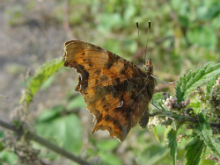_DSC_0245_28Mar17_SCP_43.jpg)
Widespread and common


Distribution and Status
The Comma is widely distributed in the two counties but it appears to be absent in a few spots in arable north-east Hertfordshire. Since the 1980s there has been a slight increase both in terms of range and abundance. There seems to be some positive correlation between winter rainfall and abundance; rainfall for the winter in the year before (Palmer et al.), for example, winter 2007-8 for total counts in 2009
Habitat Requirements
More likely to be seen in open wooded areas and hedgerows in the spring but are more regularly found in gardens to feed on nectar and rotting fruit in late summer and the autumn
Larval Foodplants
Common Nettle Urtica dioica, Wych Elm Ulmus glabra, English Elm Ulmus procera. [Hop Humulus lupulus, Gooseberry Ribes uva-crispa, Goat Willow Salix caprea, Hazel Corylus avellana. Other currants Ribes spp.]
Adult Food Sources
Buddleia Buddleja davidii, Common Michaelmas Daisy Aster x salignus, Iceplant Sedum spectabile
Behaviour/Observation notes
Males establish territories on woodland rides and hedgerows, and often perch for long periods on a favourite twig or leaf. In the spring, the butterfly sometimes feeds on willow flowers. In the summer and autumn, individuals due to enter hibernation are more sedentary but will occasionally visit gardens to feed on flowers and fruit like blackberries. Animal faeces and carcasses may attract the Comma too

Life History
The Comma produces two generations a year. Emergence from hibernation usually starts in March and the butterfly is on the wing until the end of April. The quicker developing larvae resulting from the first generation will produce a second generation in late June and July of the hutchinsoni form which have paler wings than the normal form. The slower developing larvae will however, produce the normal form in late July and early August. The female hutchinsoni form will also lay eggs and produce a new brood of the normal form in late August and September. By November, adults will go into hibernation. Eggs are laid singly towards the edge of a leaf of the foodplant. Larvae feed on the leaves and look like bird droppings when mature. The pupa is suspended attached to the foodplant or surrounding vegetation
Further information
Photo gallery
Branch Annual Report (2022)
UK distribution map
Full list of larval hostplants (Nymphalidae)
Stevenage butterflies - additional notes